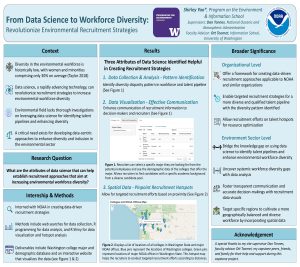FROM DATA SCIENCE TO WORKFORCE DIVERSITY: REVOLUTIONIZING ENVIRONMENTAL RECRUITMENT STRATEGIES
Workforce diversity plays a pivotal role in the environmental sector and beyond, fostering creativity and equitable decision-making. However, women and minorities are more underrepresented in the environmental field compared to the mainstream workforce, with even fewer in federal agencies. The purpose of this study is to discover how the use of data science can enhance recruitment strategies to promote diversity in the environmental workforce. To accomplish this task, I interned with National Oceanic and Atmospheric Administration (NOAA) to create recruitment strategies that promote workforce diversity utilizing web searches to collect data on Washington State colleges, R programming for data analysis, and R Shiny for data visualization and hotspot analysis. My capstone internship revealed three key findings. First, data collection and analysis can build pattern identification of workforce diversity, aiding in strategy development. Second, data visualization facilitates effective communication of recruitment information to decision-makers and recruiters. Lastly, hotspot maps pinpoint recruitment hotspots, allowing for targeted recruitment efforts based on proximity. These three attributes of data science identified in my finding—data collection, data visualization, and hotspot mapping—serve as the foundation for enhancing recruitment strategies. They offer a blueprint for best practices in recruitment, benefiting NOAA and similar environmental agencies. Moreover, these findings bridge the knowledge gap on how data science can be leveraged to establish recruitment approaches that drive diversity and increase the representation of underrepresented groups within the broader environmental community.
